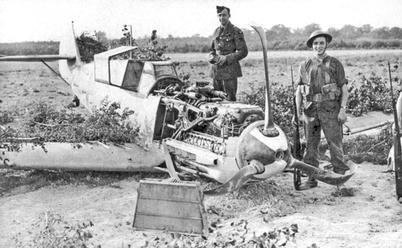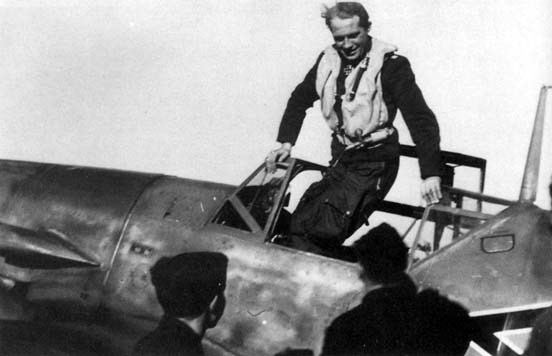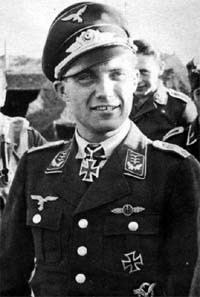Name Franz Werra | Commands held I./JG 53 Years of service 1936–41 | |
 | ||
Battles/wars World War IIBattle of BritainOperation Barbarossa Unit Jagdgeschwader 3, Jagdgeschwader 53 | ||
Franz von werra the one that got away
Franz Xaver Baron von Werra (13 July 1914 – 25 October 1941) was a German World War II fighter pilot and flying ace who was shot down over Britain and captured. He is generally regarded as the only Axis prisoner of war to succeed in escaping from Canadian custody and returning to Germany, although a U-Boat rating, Walter Kurt Reich, is said to have jumped from a Polish troopship (presumably the ex-liner Sobieski) into the St. Lawrence River in July 1940. Werra managed to return to Germany via the US, Mexico, South America, and Spain, finally reaching Germany on 18 April 1941. Oberleutnant von Werra was awarded the Knight's Cross of the Iron Cross on 14 December 1940. His story was told in the book The One That Got Away by Kendall Burt and James Leasor, which was made into a film of the same name, starring Hardy Kruger.
Contents
Biography

Franz Baron von Werra was born on 13 July 1914, to impoverished Swiss parents in Leuk, a town in the Swiss canton of Valais. The title of Freiherr (equal to Baron) came from his biological father, Leo Freiherr von Werra, who after bankruptcy, faced deep economic hardship. Because his relatives were legally obliged to look after the Baron's wife and six children, his cousin Rosalie von Werra persuaded her childless friend Louise Carl von Haber to permit the Baron's youngest, Franz and his sister, to enjoy the benefits of wealth and education. The von Habers did not tell the children their true origin.

In 1936, Werra joined the Luftwaffe. Commissioned a Leutnant in 1938, the beginning of the Second World War found him serving with Jagdgeschwader 3 in the French campaign. An able officer, he became adjutant of II Gruppe, JG 3. He was described as engaging in boisterous 'playboy' behavior. He was once pictured in the press with his pet lion Simba, which he kept at the aerodrome as the unit mascot.

Werra scored his first four victories in May 1940, during the Battle of France. Downing a Hawker Hurricane on 20 May, two days later he claimed two Breguet 690 bombers and a Potez 630 near Cambrai.
In a sortie on 25 August during the Battle of Britain, he claimed a Spitfire west of Rochester, and three Hurricanes, as well as five destroyed on the ground for a total of nine RAF planes eliminated. The details of the actions are unknown, as the incident has not been found in British records.
Capture and escapes
On 5 September 1940, Werra's Bf 109E-4 (W.Nr. 1480) "< + –" was shot down over Kent. It is unclear who was responsible for this victory, which was originally credited to Pilot Officer Gerald "Stapme" Stapleton of No. 603 Squadron RAF. However, the Australian ace Flight Lieutenant Paterson Hughes (234 Sqn RAF) was posthumously given half of the credit, in the Citation (London Gazette, 22 October 1940) awarding him a bar to his DFC. Some sources suggest that P/O George Bennions of 41 Sqn may have initially damaged Werra's fighter before Hughes and Stapleton also scored hits on it. Other sources suggest F/L John Terence Webster of No. 41 Squadron as the victor.
Werra crash-landed his Bf 109E-4 in a field and was captured by the unarmed cook of a nearby army unit. He was initially held in Maidstone barracks by the Queen's Own Royal West Kent Regiment, from which he attempted his first escape. He had been put to work digging and was guarded by RMP Private Denis Rickwood, who had to face Werra down with a small truncheon, while Werra was armed with a pick axe. (There is no mention of this escape attempt in the book The One that Got Away.) He was interrogated for eighteen days at Trent Park, a country house in Hertfordshire which before the war had been the seat of Sir Philip Sassoon. (After the war it became Trent Park teachers' training college). Eventually, Werra was sent to the London District Prisoner of War "cage" and then on to POW Camp No.1, at Grizedale Hall in the Furness Fells area of pre-1974 Lancashire, between Windermere and Coniston Water.
On 7 October he tried to escape for the second time, during a daytime walk outside the camp. At a regular stop, while a fruit cart provided a lucky diversion and other German prisoners covered for him, von Werra slipped over a dry-stone wall into a field. The guards alerted the local farmers and the Home Guard. On the evening of 10 October, two Home Guard soldiers found him sheltering from the rain in a hoggarth (a type of small stone hut used for storing sheep fodder that is common in the area), but he quickly escaped and disappeared into the night. On 12 October, he was spotted climbing a fell. The area was surrounded, and Werra was eventually found, almost totally immersed in a muddy depression in the ground. He was sentenced to 21 days of solitary confinement and on 3 November was transferred to Camp No. 13 in Swanwick, Derbyshire, also known as the Hayes camp.
In Camp No. 13, Werra joined a group calling themselves Swanwick Tiefbau A.G. (Swanwick Excavations, Inc.), who were digging an escape tunnel. The tunnel can still be seen at the Hayes Conference Centre. On 17 December 1940, after a month's digging, it was complete. The camp had forgers who equipped the escape group with money and fake identity papers. On 20 December, Werra and four others slipped out of the tunnel under the cover of anti-aircraft fire and the singing of the camp choir. The others were recaptured quickly, leaving Werra to proceed alone. He had taken along his flying suit and decided to masquerade as Captain van Lott, a Dutch Royal Netherlands Air Force pilot. He told a friendly locomotive driver that he was a downed bomber pilot trying to reach his unit, and asked to be taken to the nearest RAF base. At Codnor Park railway station, a local clerk became suspicious, but eventually agreed to arrange his transportation to the aerodrome at RAF Hucknall, near Nottingham. The police also questioned him, but Werra convinced them he was harmless. At Hucknall, a Squadron Leader Boniface asked for his credentials, and Werra claimed to be based at Dyce near Aberdeen. While Boniface went to check this story, Werra excused himself and ran to the nearest hangar, trying to tell a mechanic that he was cleared for a test flight. Boniface arrived in time to arrest him at gunpoint, as he sat in the cockpit, trying to learn the controls. Werra was sent back to the Hayes camp under armed guard.
In January 1941, Werra was sent with many other German prisoners to Canada on the Duchess of York, in a convoy departing Greenock on 10 January 1941, guarded by HMS Ramillies among others. His group was to be taken to a camp on the north shore of Lake Superior, Ontario, so Werra began to plan his escape to the United States, which was still neutral at the time. On 21 January, while on a prison train that had departed Montreal, he jumped out of a window, again with the help of other prisoners, and ended up near Smith's Falls, Ontario, 30 miles from the St. Lawrence River. Seven other prisoners tried to escape from the same train, but were soon recaptured. Werra's absence was not noticed until the next afternoon.
After crossing the frozen St. Lawrence River, Werra made his way to Ogdensburg, New York, arriving several months before the US entered the war, and turned himself over to the police. The immigration authorities charged him with entering the country illegally, so Werra contacted the local German consul, who paid his bail. Thus, he came to the attention of the press and told them a very embellished version of his story. While the U.S. and Canadian authorities were negotiating his extradition, the German vice-consul helped him over the border to Mexico. Werra proceeded in stages to Rio de Janeiro, Brazil, Barcelona, Spain and Rome, Italy. He finally arrived back in Germany on 18 April 1941.
Return and death
Franz von Werra became a hero. Adolf Hitler awarded him the Knights Cross of the Iron Cross (Ritterkreuz des Eisernen Kreuzes). Werra was assigned the task of improving German techniques for interrogating captured pilots, based on his experiences with the British system. Werra reported to the German High Command on how he had been treated as a POW, and this caused an improvement in the treatment of Allied POWs in Germany. He wrote a book about his experiences titled "Meine Flucht aus England" (My Escape from England), although it remained unpublished.
Werra returned to active service with the Luftwaffe and was initially deployed to the Russian front as Gruppenkommandeur of I./JG 53. He scored 13 more aerial victories during July 1941, raising his overall confirmed total to 21. In early August 1941, I./JG 53 withdrew to Germany to re-equip with the new Bf 109F-4, after which it moved to Katwijk in the Netherlands.
On 25 October 1941 Werra took off in Bf 109F-4 Number 7285 on a practice flight. His aircraft suffered a complete engine failure and crashed into the sea north of Vlissingen. Werra was presumed killed, though his body was never found.
Film
Werra's story was the subject of the 1957 film The One That Got Away starring Hardy Krüger as Franz von Werra. The film was based on a book by Kendall Burt and James Leasor published in 1956.
A documentary called von Werra (with clips from The One That Got Away) was released in the 2000s.
